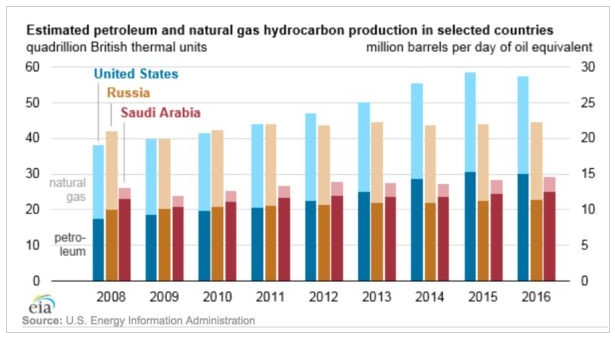The United States was the world’s top producer of both petroleum and natural gas for the fifth straight year in 2016, according to data released
June 7 by the U.S. Energy Information Administration (EIA).
 This amazing achievement is largely due to advances in horizontal drilling and hydraulic fracturing technology, firmly establishing the U.S. as the world’s leader in hydrocarbon production.
This amazing achievement is largely due to advances in horizontal drilling and hydraulic fracturing technology, firmly establishing the U.S. as the world’s leader in hydrocarbon production.
The U.S. has been the world’s top producer of natural gas since 2009, when domestic natural gas production surpassed that of Russia, and
we have been the world’s top producer of petroleum hydrocarbons since 2013, when our production exceeded Saudi Arabia’s.
This accomplishment comes just a few years after it was widely assumed the U.S. production was in irreversible decline.
U.S. oil production was down slightly in 2016 due to consistently low commodity prices. In addition, an unusually warm winter resulted in less
demand for natural gas. For most of 2016, U.S. natural gas prices were at their lowest level since 1999, contributing to an output reduction of 2.3
billion cubic feet per day (bcfd).
In spite of this, domestic output of oil and gas still far outpaced other countries.
It appears the U.S. will maintain its global dominance for the foreseeable future. The EIA noted in its June 6 Short Term Energy Outlook that
oil production should reach 9.3 million bpd in 2017, up from 8.9 million bpd last year, in addition to shattering the all-time production by reaching 10
mbpd by 2018.
Natural gas production is also well situated for growth, with the EIA forecasting a 1 billion cubic foot per day rise in natural gas
production this year, approaching the record production of 2015.

